I can best sum up Jumanji: Welcome to the Jungle by saying that I could have read the Wikipedia summary and not have missed any important beats. There are a couple of funny moments from the core foursome (Dwayne Johnson, Kevin Hart, Karen Gillan, Jack Black) embodying archetypal teens inhabiting stereotypical video game characters, and a few begrudging callbacks to the 1995 film, but make no mistake: This movie is not worth a roll of the dice. I can’t really call it a sequel because most sequels at least pretend to care about the world of their predecessors; nor is it a reboot, since it’s not retelling the original story in a fresh way.
Similarly, the movie wobbles between acknowledging Jumanji at all and satirizing video games, without ever landing on a side. In fact, the more fitting spiritual sequel to Jumanji is User Unfriendly, Vivian Vande Velde’s 1991 novel combining virtual reality and Dungeons & Dragons.
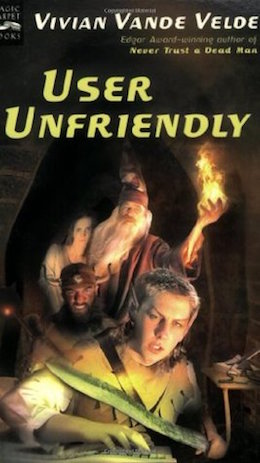 Vande Velde’s little-known tale follows teenage Arvin and his friends (and his mom), who have jacked into Rasmussem, Inc.’s VR fantasy game to play out a D&D-esque campaign. Their only directive: Find Rasmussem—which could be a person, place, or thing, depending on what iteration of the game you’re playing. The fact that Arvin’s friend Shelton has hacked them into a pirated version of the game is initially only a worry related to whether their directive will translate to the bootleg version… until glitches start breaking up the fabric of their fantasy world, and they discover that they can’t unplug until they complete their quest.
Vande Velde’s little-known tale follows teenage Arvin and his friends (and his mom), who have jacked into Rasmussem, Inc.’s VR fantasy game to play out a D&D-esque campaign. Their only directive: Find Rasmussem—which could be a person, place, or thing, depending on what iteration of the game you’re playing. The fact that Arvin’s friend Shelton has hacked them into a pirated version of the game is initially only a worry related to whether their directive will translate to the bootleg version… until glitches start breaking up the fabric of their fantasy world, and they discover that they can’t unplug until they complete their quest.
As a kid who didn’t play video games beyond some Tetris and Super Smash Bros., and preferred fantasy novels to D&D campaigns, I found this mashup premise fascinating. It doesn’t entirely hold up on later reads, as it was written for both the intended age group (10 and up) and the time, with explanations of REM and aneurysms, plus outdated technology—not to mention the lol-worthy covers. However, the story possesses an earnest cheesiness matched by the tone of Jumanji. There was something so awe-inspiring about transplanting jungle animals into the suburbs: humans being faced with the overwhelming power of nature, completely out of their element; participating in a game made of such pure evil that every move was a misstep, every roll a trap.
Which is why the premise of Welcome to the Jungle’s video-game world is seriously flawed: The players must return the green gem of Jumanji (which vaguely resembles the verse-spouting crystal ball of the original game) to its rightful place, in order to save the land of Jumanji from the curse that has befallen it.
Why would anyone want to save Jumanji? Jumanji is nightmare fodder. Jumanji is deviously creative torture. Jumanji should be burned in a dumpster fire.
That’s the first mistake in Welcome the Jungle. Here’s what else it could have learned, from both its supposed predecessor and from User Unfriendly.
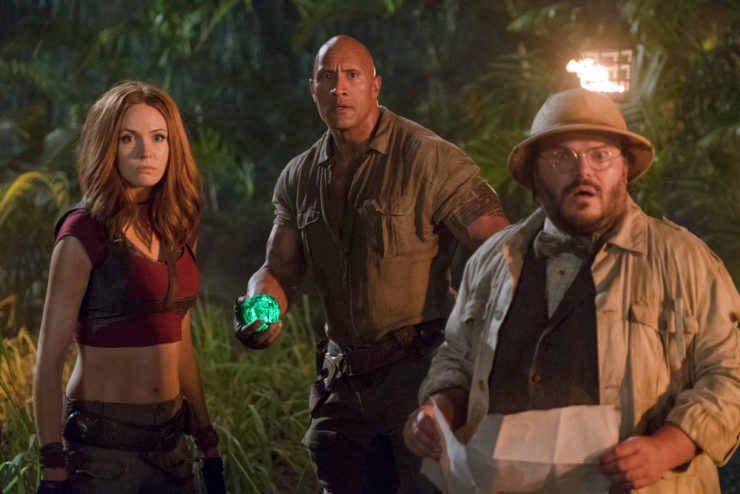
Acknowledge your world’s mythology. I refuse to believe that a herd of rhinos stampeding through a New Hampshire town and a crazed hunter racing through a shopping mall with a rifle like it’s his own personal safari in 1995 never made it into urban legend lore in 1996 (where the opening scene of Welcome to the Jungle is set), or that a clunky board game that sucked people into it didn’t surface in creepypasta in 2017 (where the rest of the movie takes place). Yes, winning the game in Jumanji reverts its players to an alternate timeline where the game never screwed up their lives, but they still retain all of their memories of the experience; what’s to say that other people who had been terrorized by the animals wouldn’t possess the same collective memory and pass it on?
User Unfriendly, the first in a series, sparingly but effectively constructs a framework around the Rasmussem Corporation and its obsession over profit translating into its incredibly dangerous video games. At the very least, Welcome to the Jungle could have had one of the four kids connect the disappearance of Alex Vreeke (the Alan Parrish stand-in) in 1996 to that creepy game they heard about on the r/nosleep subreddit, instead of saying, “What’s this Ju-MAN-ji game?”
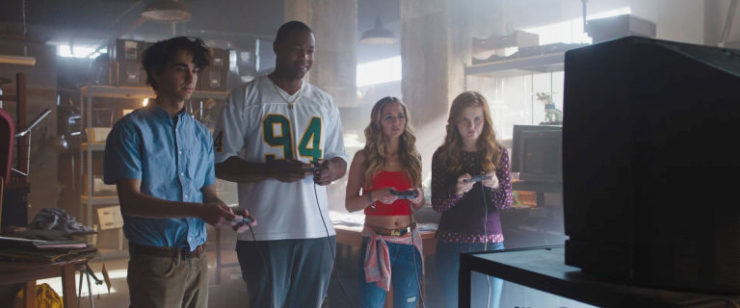
More dimension to the real-world players. Welcome to the Jungle’s humor coasts entirely on the fact of each of the four Jumanji video game characters act as a one-dimensional foil of the similarly one-note teenagers who randomly choose them: Nerdy Spencer can lose himself in the mountainous persona of Dr. Smolder Bravestone (Johnson), named for one of his powers. In Franklin “Moose” Finbar (Hart), football player “Fridge” loses two feet in height and all of his athletic ability, and is reduced to Spencer’s sidekick. Awkward but brilliant Martha is stuck in the Lara Croft knockoff body of Ruby Roundhouse (Gillan). And selfie-obsessed Bethany becomes the ugliest avatar she could ever imagine, portly middle-aged Dr. Shelly Oberon (Black).
Likening these four teenagers, who play the vintage-looking Jumanji game as a distraction from detention, to the Breakfast Club is an insult to the Breakfast Club. Their singular traits, and the ways in which their avatars represent the exact reverse, read like shoddily-thrown-together D&D characters. There are only so many ways that Hart can screech about being the metaphorical football kicked around, and he’s used them up on funnier movies (like in his and Johnson’s buddy comedy Central Intelligence). Black, bless him, is fairly amusing as a mincing teenage girl, and there’s a flicker of pathos as Bethany learns to focus on something other than herself, but that gets tired quickly. There is some merit to watching Spencer and Martha self-consciously embrace their beautiful bodies and the incredible abilities they afford, only to agonize over if the other won’t prefer their real-world selves once they get out of the game. But that’s only a moment in a movie dominated by mostly mindless and unsatisfying action sequences.
Here, the humor relies on knowing exactly who inhabits each avatar. Where User Unfriendly succeeds is that Arvin spends most of the book trying to discern which of his friends has chosen which character: one guy has, puzzlingly, chosen a Native American warrior; the lovey-dovey teen couple are clearly Robin Hood and Maid Marian, though he gets the genders wrong; the girl who love-hates him plays an elf, as does he, but she gets the opportunity to beat him up whenever she wants. Most interesting are the inclusion of Arvin’s mother, who gets cast as a sort of wench, to his utter humiliation; and Shelton, the aforementioned hacker, who regularly saves the group’s collective asses as an all-powerful wizard—but is revealed at the end to have cerebral palsy, confined to a wheelchair and reliant on voice-activated software. Most of these reveals happen in the latter half of the book, allowing the reader, like Arvin, to make their own guesses.
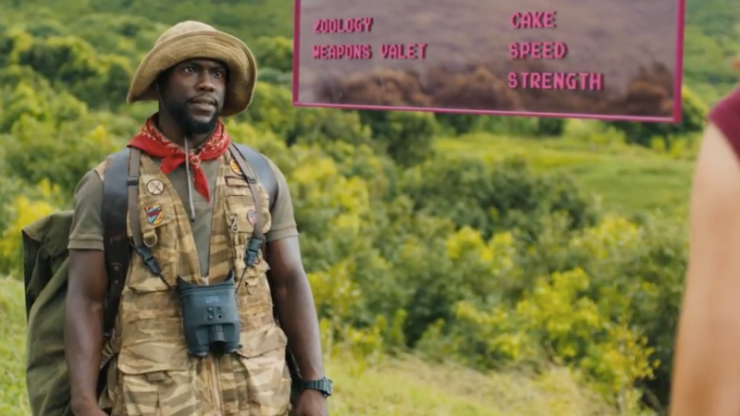
Play to the video-game setting. As they’re already playing a pirated version of the Rasmussem game, Arvin and his friends have no problem artificially inflating their stats—though those upgrades, including a glowing sword, come back to bite them in the ass. But in Jumanji, Spencer and his friends’ character stats, like their appearances, just make for one-note gags: Cake makes Moose explode, for some inexplicable reason, while Ruby Roundhouse’s talent is dance-fighting—which, to be fair, leads to one of the movie’s few hilarious sequences, two fight scenes set to “Baby I Love Your Way.”
But if the adventurers are in a video game, why not have them gain XP and level up? Or obtain weapons upgrades? Or do anything but worry about their three lives (after which it’s “you die in the game, you die for real”)? If Welcome to the Jungle was so committed to being a commentary on video games, there were a lot tropes the screenwriters could have played with.
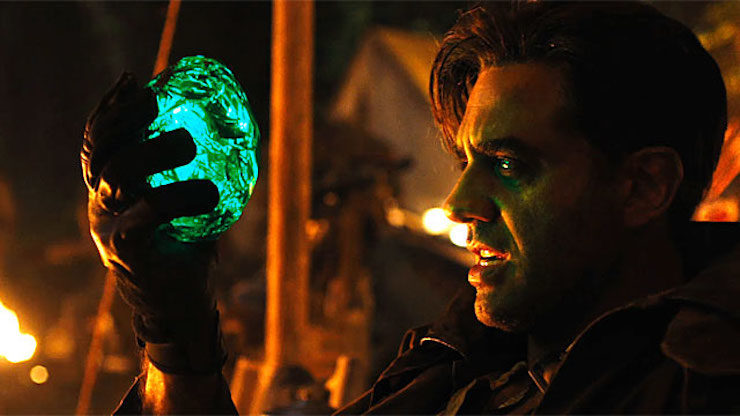
Make the in-game characters more ominous. To wit: A game is nothing without its non-player characters, or NPCs. Welcome to the Jungle misses the opportunity to comment on the supporting characters that make up the fabric of this quest-based game, instead retreading the same joke about NPCs reciting their scripted lines over and over without it actually going anywhere. By contrast, User Unfriendly explores what happens when characters confront something they haven’t been programmed to deal with: when one of the characters mutters about it being “just a stupid game,” NPC Simon Abbott cocks his head and asks, “Game?” while NPC Brynhild shudders. They continue in that loop, over and over: “Game?” Shudder. “Game?” Shudder. Eventually, the players have to leave the NPCs behind, caught in an eternal loop. It’s one of the most chilling moments I’ve ever read in a fantasy novel.
The character meant to inspire the most fear in Welcome to the Jungle is Russel Van Pelt (Bobby Cannavale in a headscratcher of a role), an explorer who stole the Jumanji MacGuffin and, under its curse, was transformed into a one-eyed villain who controls every animal, from the jaguars to the scorpions. Naming him Van Pelt was a bone thrown to fans of the original movie, but he completely lacks the menace of that hunter—not least because what made the original Van Pelt most disturbing was that he was played by the same actor who played Alan Parrish’s father. Imagine being hunted through the jungle for 25 years by a man with the face of your father who wanted to send you away to boarding school after you messed up his factory. It’s dark little moments like those that make Jumanji memorable.
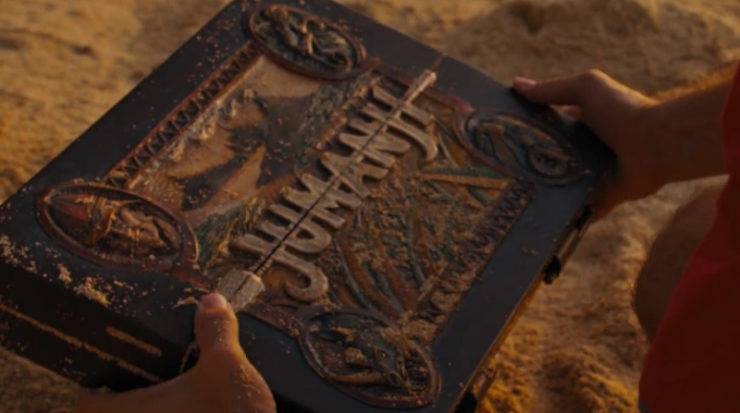
Establish actual real-world consequences. In the original movie, the game kept conjuring up new jungle horrors and dumping them in the real world: Elephants stampeding in traffic. A lion roaring from the den. A boy gets turned into a freaking monkey just for cheating. This board game doesn’t mess around.
But because Welcome to the Jungle is set entirely within the video game, all of the action is constrained to this digital universe, and you lose any interesting incongruity. The threat only extends so far as the borders of the game; no one in the real world is in any danger, nor is there any consideration given to their real-world bodies. User Unfriendly builds up the suspense by constantly reminding its players that their bodies are unconscious and vulnerable in a basement somewhere while the bootleg game slowly fries their brain cells and causes Arvin’s mother to begin complaining about a headache and flickering ominously.
Interestingly, the tagline of the Jumanji game itself never quite jibed with the personal arcs of the kids who discovered it: A game for those who seek to find a way to leave the world behind. It does give Alan an alternative to boarding school, but it’s not a very good alternative. Bringing the animals into the real world doesn’t quite translate, either. I will give Welcome to the Jungle, which resurrects that phrase in the video game’s pixelated opening, some points for hewing closest to the message: Spencer wrestles with the temptation to be Smolder Bravestone forever, afraid of returning to his puny real-world existence. But I suspect I’m giving the movie too much credit.
If you really want to leave the world behind, I recommend that you rewatch Jumanji for the childlike wonder, then read User Unfriendly for an actually immersive experience. Leave Welcome to the Jungle in the trash pile.
Natalie Zutter was really tickled to see the serial killer from “Too Many Cooks” in his tiny cameo. Talk old fantasy novels and sequels with her on Twitter!










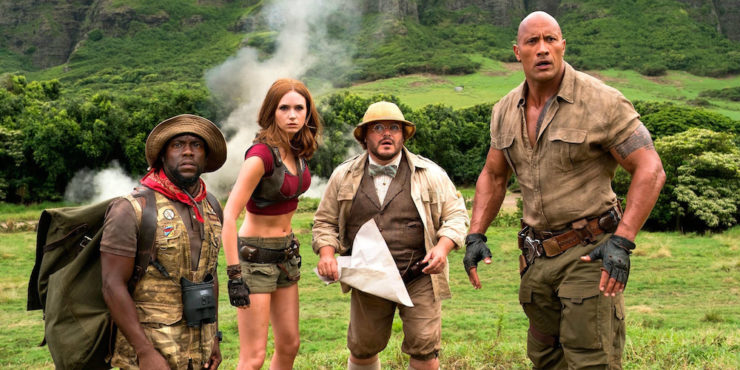
Maybe because they are stuck inside the game and have no choice but to play or die?
Maybe it’s just me, but I thought it was interesting that the author was internet-steeped enough to mention r/nosleep but apparently not enough to talk about the flood of isekai that’s drowing other corners of the genre.
It sounds like the screenwriter or screenwriters thought they knew about modern video games, but haven’t actually played them.
2, indeed, there are a LOT of Isekai’s in Japanese anime, but also plenty of other books that cover the phenomena in various ways. From say, Guardians of the Flame to The California Voodoo Game.
And I’m pretty sure that both Jumanji and Zathura did create a huge reset button where everything that happened before was undone.
@@.-@: Not to mention Quag Keep by Andre Norton (the first ever D&D novel), the Dungeons & Dragons cartoon (kinda-sorta), and a certain webcomic which I won’t name because it would be a spoiler.
I’ve never read User Unfriendly, but the description reminds me of another book I read years ago called Wyrm, which can basically be summed up as “What if the Y2K bug was sentient?”
5, damnit, now I have to guess what Webcomic it is. It’s not Goblins or Erfworld, is it?
@76: No, neither of those. I haven’t read Goblins, but in Erfworld, at least, it’s clear from the outset that the protagonist is trapped in a game (or at least a world that behaves like one). In the webcomic I’m referring to, it’s not revealed until several chapters in that the characters are in a game. If you really want to know, here’s a link.
” I refuse to believe that a herd of rhinos stampeding through a New Hampshire town and a crazed hunter racing through a shopping mall with a rifle like it’s his own personal safari in 1995 never made it into urban legend lore in 1996″
Because it never happened? In the original the events of the movie were erased at the end. Alan was sent back to the moment he was taken by the game and only he and Sarah remember what happened. The Shepard siblings never play the game in the new timeline, so they rhinos never got a chance to rampage through the streets.
I have read and loved “User Unfriendly” (and also “Heir Apparent” by the same author, with a similar premise) so I was really looking forward to this – and loved it! I thought the acting was really wonderful – you really believe there’s a terrified nerd inside Dwayne Johnson’s body. And I absolutely loathe “The Breakfast Club”, so it’s nice to have a version that’s actually entertaining!
And there’s a reason they’re not trying to match “modern video games” – this is supposed to be a game console from 1996. I didn’t play video games, but the setup looked about like what I would see when I was over at my cousins’ house and they were playing.
I’m sorry you didn’t like this movie. Maybe we can get a review from someone who didn’t hate it?
I agree with @9. This isn’t supposed to be a modern video game. This is a FFVI-level video game. This is Super Nintendo, or N64 at best. Its Retro to these kids.
Why would anyone want to save Jumanji? Because it’s a beautiful place, and home to many, but suffering from an awful curse and terrible villain, remove the curse and villain and it’ll be well worth keeping, I’m sure…
I kinda get the video game criticisms, but agree, it’s retro 90s console stuff.
But then it’s always been a complaint of mine, movies, who make a shedload of money on video game tie ins, still seeming to portray gamers as losers, and portray them playing Mario on a playstation, with an Atari 2600 rubber joystick, and dumb sound effects dubbed over, and there’s always be at least two people playing a single player game, frantically button mashing.
I read the teaser paragraph for this essay when it was initially posted — and deliberately refrained from reading further till I’d had the chance to actually see the current movie, which came earlier today. That was wise, I think, and here’s why: I was able to view the movie on its own terms and its own merits.
One lesson I’ve learned in several decades of both professional and informal reviewing: it’s almost always a bad idea to spend the majority of your word count talking about things that aren’t actually in the movie/book/stage production. It isn’t inappropriate in principle to say “this other work does X better”, or “the production should have done Y instead of Z”, but it’s all too easy to end up — as I think we do here — with an essay that’s less about the current movie than it is about the movie that the reviewer wanted and didn’t get.
As it happens, I never saw the original Jumanji movie, though I absorbed the premise via general fannish osmosis and brief encounters with snippets of the animated spinoff series. I was attracted to the present film specifically via the trailers, which turned up several times ahead of various summer and fall blockbusters. And I was not disappointed. To my mind, Jumanji: Welcome to the Jungle does much the same creditable job that last March’s underrated Power Rangers movie did: it takes a complicated, multi-threaded creative property and reinvents it in straightforward, streamlined form aimed primarily at new viewers rather than the existing franchise’s fanbase.
What I particularly liked: as in Power Rangers, the kids we meet in the opening scenes are believable 21st century high school kids…who turn out, when thrown into a totally off-the-wall situation, to be much more adaptable than even they expect to be. More — and this is important — when our kid heroes abruptly morph into their Jumanji avatars, I had absolutely zero trouble buying that I was watching the same young characters with more mature bodies and voices. That suggests both sharp character work in the scripting and really good technical work by the adult actors, because my suspension of disbelief didn’t slip for even an instant . [A particular callout here: the scene two-thirds or so of the way in when two of Our Heroes share their first romantic moment, which is exactly the right levels of realistically awkward and awkwardly realistic.] I also liked the characters’ clever use of game mechanics, notably those involving strategic deployment of “spare” lives.
Are there aspects that could have been better developed? Yes; in particular, the film is fuzziest in those moments when it’s not operating from the players’ POV. The very beginning, when the hardwood gameboard morphs into a video cartridge, hints at a power behind the game that we never see again — and should, because whatever Van Pelt represents, he’s not limited in the same ways as the clearly labeled NPCs. And then there’s the underexplored mystery surrounding the school principal, whose staple-removal assignment is an awfully convenient catalyst for the whole adventure.
In general, though, I think Jumanji: Welcome to the Jungle succeeds as a free-standing work, and I would caution moviegoers strongly against going into the theater with significant pre-existing expectations. This movie relates to the original Jumanji in much the same way that Tim Burton’s Batman movie relates to the 1966 Adam West feature — both are different, equally valid riffs on a common theme, and no more.
If one insists on comparisons to other similar tales, I’d also submit that there are better examples than User Unfriendly. On the screen side, Tron and The Last Starfighter are both more direct parallels in terms of premise (and, if you stretch the metaphors a bit, the resonances with Pleasantville are worth considering); the animated Dungeons & Dragons TV series is also specifically relevant. As for print examples — I have my own issues with Ernest Cline’s Ready Player One, but that’s surely the most direct modern ancestor to the present movie. I’d also strongly recommend Wm. Mark Simmons’ Dreamland Chronicles (if you can find a copy) and Diane Duane’s Omnitopia Dawn.
Like all of the Rock’s movies, the movie is supposed to be dumb fun. You turn off your brain, laugh at some goofs, and enjoy the explosions.
The movie accomplished that.
Tor – I’m going to need to start only going to films you *don’t* recommend…as the trend lately for me is the movies your writers like, I dislike…and vice versa. I do appreciate your writing, Natalie – but I would disagree that this movie isn’t “worth a roll of the dice”. I’m sad I missed out on it in theaters.
Over the weekend, my roommate bought this on Amazon and we had some friends over for pizza & movie…and we all had a blast with this film. I’ve not laughed this much to a movie in quite some time…the cast was fantastic, the dialogue was well-written and the story was serviceable. All in all, a very worthwhile movie…and better than that, it was a very *fun* movie!!